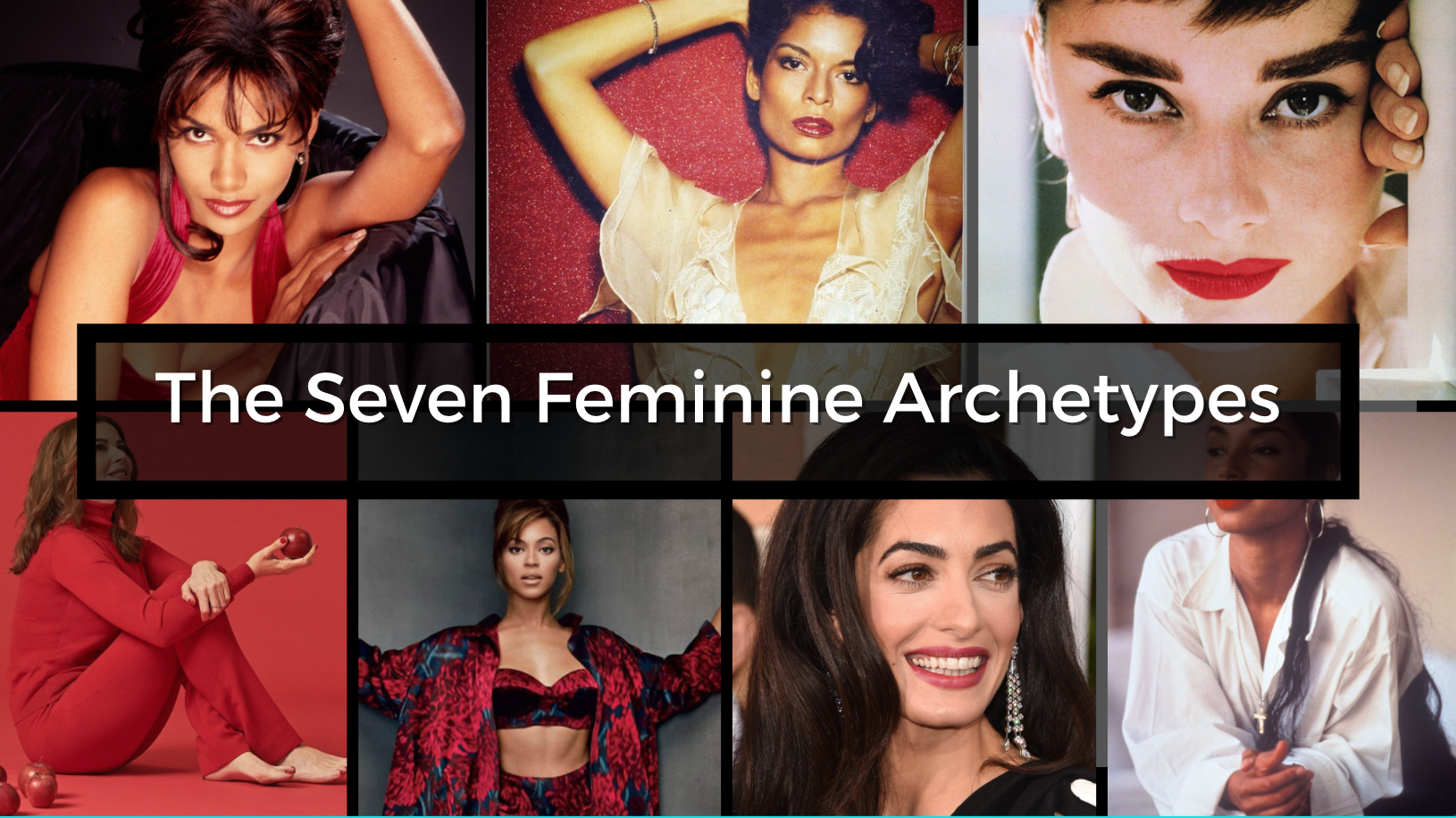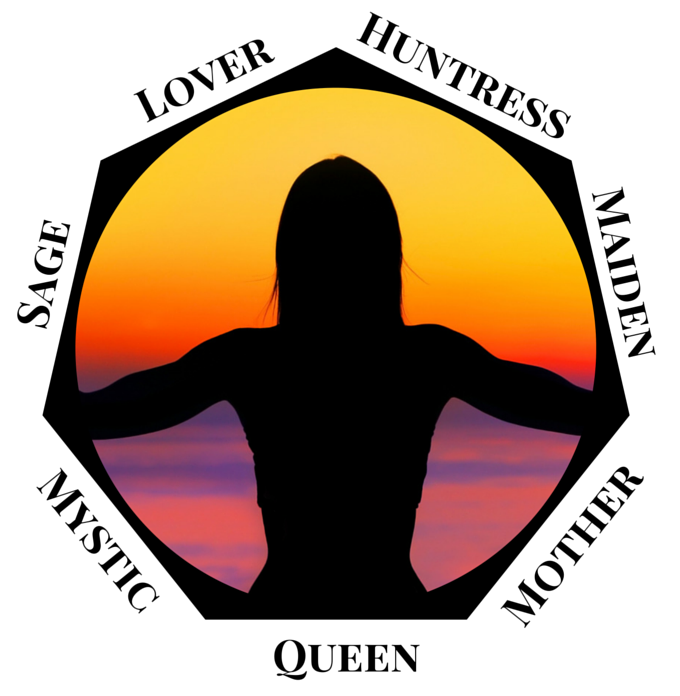 ©2021. All rights reserved.
©2021. All rights reserved.
An archetype is to the psyche what the body is to the mind.
There are seven feminine archetypes that prevail in contemporary western society—the mother, the maiden, the queen, the huntress, the sage, the mystic, and the lover. The presence of these archetypes in our psyches accounts for the major differences among women.
Swiss psychiatrist Carl Jung pioneered the use of archetypes in depth psychology, even though the concept of archetypes predates even him. Today, archetypes are commonly studied by Jungian analysts, mythologists and writers alike– but it’s important to note that while Jung pioneered archetypal psychology, he didn’t actually author the seven feminine archetypes which many resources wrongfully assert.
There are several schools of thought, hence multiple approaches to defining the feminine archetypes that dominate any society at any given time.
The following seven archetypes, and their names, reflect my decade-long research into mythology and archetypal psychology. I’ve lectured on the connection between archetype and culture all over the world and my work explores the pre-patriarchal, pre-Hellenic origins of contemporary archetypes in order to distill much more authentic, holistic models of feminine power.
What is an archetype?
Archetypes form the basis of all unlearned, instinctive patterns of behavior. These powerful universal symbols exist in what pioneering psychologist Carl Jung referred to as the “collective unconscious”. A reservoir of human experience, the collective unconscious looms over the individual psyche like a shadow, quietly influencing our actions and reactions.
Humans are hardwired to integrate and respond to archetypal images in a way that is completely beyond their conscious control. Marketing execs and Hollywood studios have long capitalized on this psychology, using it to create inspiring stories, mega stars and profitable brands. Public figures who appear larger than life often trigger deep archetypal responses within us, like Mother Teresa; the selfless, archetypal mother and Martin Luther King; the archetypal male Messiah.

Each feminine archetype is a unique expression of feminine energy, to which we all have access.
The personality Differences Among Women
The presence of these archetypes in our psyches, to varying degrees, accounts for the major personality difference among women– they are the quiet forces that shape the arc of our lives. Our signature feminine archetype quiz offers a snapshot of how you personally connect with each archetype.
Each and every one of us needs to establish some connection with all seven feminine archetypes to thrive.
The lover is our gateway to sacred sensuality, creativity, passion, and our innate ability to captivate. The huntress is our path to independence and our warrior spirit. The maiden offers intuition, creativity, and the ability to evolve during periods of darkness. The sage is a gateway to accomplishment, wisdom, and the ability to compartmentalize our emotions. The queen is the key to confidence, leadership, alliances, and the ability to attract the finer things in life. The mother is our connection to our ability to nurture, create, protect, and establish deep, heart-centered relationships. And the mystic is our pathway to freedom, inner peace, and the seductive allure of mystery.
These 7 basic feminine archetypes are also the foundation for my unique captivation theory. To better understand the 13 seduction archetypes, I recommend you read about the 7 feminine archetypes on which my system is based.
The Lover Archetype
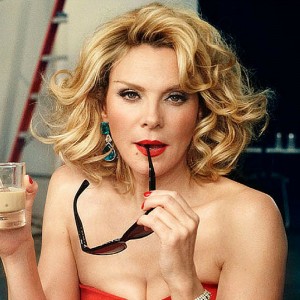
In Myth: Aphrodite, Venus, Ochun, The Sirens, Inanna, Qondita, Astarte, Hathor, Mami Wati, Erzuli, Xochiquetzal, Venus of Willendorf
As a psychological archetype: The lover archetype represents a woman’s most primal urge to connect and create. As the oldest feminine archetype (the earliest known erotic deity dates back to 30,000 BC), the “lover” represents a woman’s erotic energy and her capacity for psychic and physical creation.
When this archetype is active in a woman’s psyche, she feels compelled to fulfill both procreative and creative instincts. Her energy field is charged, and she becomes a magnet to those around her. She has presence, and she’s firmly rooted in the here and now.
The lover archetype has nothing to do with traditional sex appeal or male-authored images of pinups that may come to mind.
The lover archetype represents a life force energy. One one hand, it is this creative energy that compels us to mate and pass on our genes. But in a broader sense, this life force energy, whether referred to as shakti, chi, or anything else, compels us to channel our feelings of passion into creation- whether that creation is another human being, an intense connection, a work of art, a poem, a theory, an invention, or even the manifestation of a new reality.
Women who are aligned with the lover archetype, are intimately connected to this creative energy, their sacred eroticism, sensuality, passion, and above all, pleasure. It’s not unlike the Yoruban goddess Oshun who represents the sweet waters and in essence the ‘sweetness’ of life. It’s an energy channel available to every human being.
The lover archetype inspires deep communication, intimacy, sensuality, and creativity. Lover women are unique in that they have a deep emotional need for both freedom and connection, and their romantic lives often reflect this. Everyone has access to the “Lover” archetype. To learn how this magnetic energy relates to our ability to captivate– read here.
Strengths: Naturally magnetic, incites arousal and passion in others, creative, independent, pleasure-oriented
Challenges: vanity, lack of focus, fragile self-esteem
Watch the lover archetype video:
The Maiden Archetype

In myth: Persephone, Prosepina, Inanna, Isis, Minoan Snake Goddess.
As a psychological archetype: When the maiden archetype is dominant in a woman’s psyche, she exudes an effervescent, eternally youthful quality. In the negative, this archetype predisposes a woman to be both compliant and passive. Many young women pass through a maiden phase, prior to marriage, motherhood, and career, before she has established a clear identity for herself.
The Greek Goddess Persephone’s journey into the underworld teaches us a lot about how the “maiden” archetype manifests itself. Persephone, the innocent maiden, was abducted by Hades, God of the underworld, and separated from her protective mother Demeter. She ultimately becomes Queen of the underworld, dividing her time above and below ground.
In reality, a “maiden” woman may resemble Persephone the sheltered daughter, the runaway, or the queen. As the daughter, the “maiden” is receptive, sexually unawakened, vulnerable, and generally waiting for life to happen to her. As the “runaway”, the archetype presents as a creative, irresponsible, rebellious woman (think pop star Rhianna) who finds herself drawn to risky situations, and even dark, abusive men.
“Maidens” mature fully-integrated and self-actualized women, only after enduring significant emotional and/or physical loss. In this way, their archetype also mirrors the descent of the Sumerian goddess Inanna into the frightening depths of the underworld, where she is stripped of her power and hubris and repeatedly humiliated until she is rescued and replaced by her husband. A maiden may very well find her own strength, and the seeds of her maturation, in circumstances of extreme powerlessness.
Mature “maidens” are creative, compassionate, spiritual, and capable of displaying profound inner strength.
Greatest Strengths: Empathy, creativity, receptiveness
Challenges: Emotional Co-Dependency, diffidence, lack of autonomy, may be drawn to dangerous relationships
Watch the video:
The Mother Archetype

In Myth: Demeter, Ceres, Yemanja, Anahita, Nut, Cybele, Gaia, Tara, Tlazolteotz, Akua’ Ba, Gwandusu, Isis, Kali Ma
As a psychological archetype: When the “mother” archetype is dominant in a woman’s psyche, she is a natural caretaker. The “mother” archetype represents a woman’s maternal instinct, the desire to create life and to provide physical, mental, and spiritual sustenance.
Unlike “the lover” which inspires a woman to procreate, the “mother” is driven by the actual idea of motherhood. Even when a “mother” woman is childless, or beyond childbearing years, she is responsible, protective, and finds great satisfaction in taking care of others. “
Mothers” run the risk of putting others before themselves, and neglecting their own needs. They often find it difficult to maintain personal boundaries, a characteristic that makes them phenomenally emotionally accessible, but often feeling encroached upon and depleted of their vital energy. As maternal persistence is often an aspect of this archetype, she may be deeply stubborn.
Greatest Strengths: Nurturing, persistent, compassionate, grounded
Challenges: self-neglect, stubbornness, difficulty letting go of caretaking role, lack of boundaries
Watch the Mother archetype video:
The Queen Archetype

In Myth: Hera, Juno, Frigg, Isis, Parvati, Asherah
As a psychological archetype: In myth, “queen” deities, like Hera, wife of Zeus and Isis, wife and savior of Osiris, protect the sanctity of marriage. As an archetype, the “queen” represents loyalty, female sovereignty, and matrimonial devotion.
Regal, stately, and naturally confident, the “queen” woman is motivated by a goddess-given instinct to marry and build meaningful alliances. The “queen” archetype can make a woman feel incomplete without a partner. She doesn’t enjoy her single days nearly as much as her female counterparts.
As a leader, “queen” women are capable of taking charge at home, on a board, in an office, and running a business– particularly a female-oriented enterprise like Mary Kay Ash and Helena Rubenstein. She is often the “Queen B” of her circle of friends and a natural social butterfly.
As a companion, “queen” women are often attracted to powerful, assertive men, and are capable of demonstrating complete loyalty to their spouse and his personal goals. Like Hera of myth, who was repeatedly humiliated by Zeus’ many extramarital affairs, queen women are predisposed to feel jealousy and rage towards other women, particularly those who threaten their position socially or their status as a wife. They are likely to overlook their partner’s transgressions for the sake of the marriage.
Greatest strengths: Loyalty, leadership
Challenges: Jealousy and vindictiveness
Watch the queen archetype video:
The Huntress Archetype
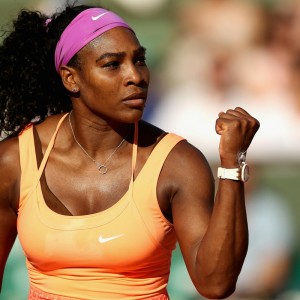
In Myth: Artemis, Diana, Banka-Mundi, Medeina, Ishtar, Nujalik, Pinga, Oya
As a psychological archetype: The “huntress” is a personification of the independent female spirit. She represents a woman’s autonomy and ability to pursue a life of her own choosing. When this archetype is dominant, a woman’s primary concern will be autonomy and attaining her personal goals. The archetype endows women with the innate ability to focus on goals, undistracted by competition or the needs of others. In this sense, she is the ultimate archer. The “huntress” lines up her bow and takes aim.
“Huntress” women often embody the qualities idealized in the women’s movement—competency, independence from men and male opinion, and commitment to causes about which they are passionate particularly women’s causes. “Huntress” women are often natural protectors of other women, particularly those who’ve been victimized.
Greatest strengths: self-reliance, courage, goal-orientedness, often sympathizes with women’s causes
Challenges: can be aloof, emotionally unavailable and potentially cruel
Watch the huntress archetype video:
The Sage Archetype

In Myth: Athena, Neith, Anat, Astarte, Anahit, Bellana, Durga, Freyja, Inanna, Ishtar, Sekhmet, Pele, Oya, Nike, Minerva, Lilith
As a psychological archetype: The sage archetype represents a woman’s pursuit of worldly knowledge, strategy, and objectivity. Sage women face the world by arming themselves with information and forming meaningful alliances. Many female attorneys, academics, and politicians are motivated by the sage archetype which encourages discipline, the pursuit of knowledge, proximity to power, and goal-orientated news. Hillary Clinton embodies this archetype closely.
A woman who identifies with the sage archetype is capable of becoming a brilliant strategist; seeing situations from an objective distance is her gift. She is also capable of becoming a skilled lover when she applies her quest for knowledge to the love arts.
Women dominated by this archetype are often practical, competent, and competitive. In Greco-Roman myth, Athena is viewed as a protector of patriarchal values. As Zeus’ favorite daughter, she is sometimes referred to as “father’s daughter”. In patriarchal societies, sage women often naturally identify with men and are often the product of strong paternal influence, or the maternal influence of a woman who also embodies the archetype. They are drawn to powerful men and are perhaps best suited for corporate life.
Sometimes these women struggle to form meaningful relationships with other women, and in extreme situations, they may use their emotional aloofness to intimidate the women in their midst.
Greatest Strengths: Emotional objectivity, worldliness, intelligence, natural strategist
Challenges: Frigidity, emotional unavailability, aloofness, closed off from sensuality and creative energy
Watch the sage archetype video:
The Mystic Archetype

In Myth: Hestia, Vesta, Ainu Kamuy, Berahynia, Chantico, Gabija
As a psychological archetype: As an archetype, the mystic is a deeply introverted woman, focused on her inner-spiritual world, and most concerned with maintaining zen-like inner peace. While the “huntress” and “wise woman” use their direct energy to focus on external goals, the mystic focuses her energy on inner fulfillment. She values solitude and carries a figurative “hearth” with her, in that she very much feels at home in her skin.
Regardless of the situation, women who experience a heavy “mystic” influence are capable of detaching themselves from emotional situations and outcomes. She may even appear cool and detached as she focuses her emotions are inward. The mystic is at peace meditating, volunteering, creating or following a spiritual path. This archetype is prevalent in religious sisterhoods.
Under-represented in the female population, the mystic represents the importance of going inward to find meaning, a quality that is often downplayed and dishonored in Western Society. Whether you are naturally aligned with this archetype or not, the cultivating the mystic is helpful for all women for achieving balance and emotional distance.
Greatest Strengths: confidence, deep concentration, creativity, prioritizes inner-peace, captivating soulful quality
Challenges: deep introversion, social isolation, emotional frigidity
Watch the mystic archetype video:
How the 7 Feminine Archetypes Work Together
Any or all of the archetypes may exist in a woman’s psyche at any given time. As we enter certain phases in our lives, for example, college (wise-woman), marriage (queen), or motherhood (mother), we activate different archetypes. Every time we fall in love or feel passionate or feel passionate about a creative project, we activate the “lover” archetype.
Imagine a meeting where your ego is the moderator and the various archetypes that motivate you all to have a seat at the table. Perhaps, as your dominant archetype, the voice of the nurturing “mother” exerts the most influence at the meeting, followed by relationship-seeking “queen”, and perhaps every once in a while the passion-seeking “lover” interjects. This is what we experience whenever we make a decision.
When we feel pulled in different directions it is typically because different archetypes existing in our psyche want different things; the angst one might feel when choosing between law school (sage) and creative entrepreneurship (lover), between becoming a stay at home mother (mother), or continuing the corporate climb (sage), or even between remaining in an unfaithful marriage (queen) or starting anew (huntress).
The archetypes within us can work together to achieve a common goal, for example, the sage can help the lover complete her creative projects, and the lover can help the queen land the husband she desires, but these archetypal drives may also clash. That’s the therapeutic value of identifying your dominant archetypes.
The 13 Feminine Seduction Archetypes quiz is a personality assessment that, in addition to identifying your seduction archetype, reveals how you identify with all 7 female archetypes. This information is incredibly impactful. Armed with an understanding of your female archetypes, you can then choose to develop your strengths, address your weaknesses, resolve internal conflict, and pursue a path that resonates with the woman you are at your core. Archetypes are a doorway to self-awareness and personal power.
How to Harness Your Unique Personality Blueprint
When you tap into your defining archetypes, you connect with the essential truth of who you are. In a world that tirelessly attempts to reduce women to ciphers — archetypal wisdom brings us authenticity, confidence, and unfathomable power.
When we are aligned with our archetypes, we experience fast progress and deeper levels of fulfillment. When we are not aligned, we feel stuck, or connected to our archetypal shadow. The beauty of archetypes is that they are effective for all types of growth and change. You can harness archetypes to improve your confidence, wellbeing, and your ability to create wealth and attract satisfying relationships.
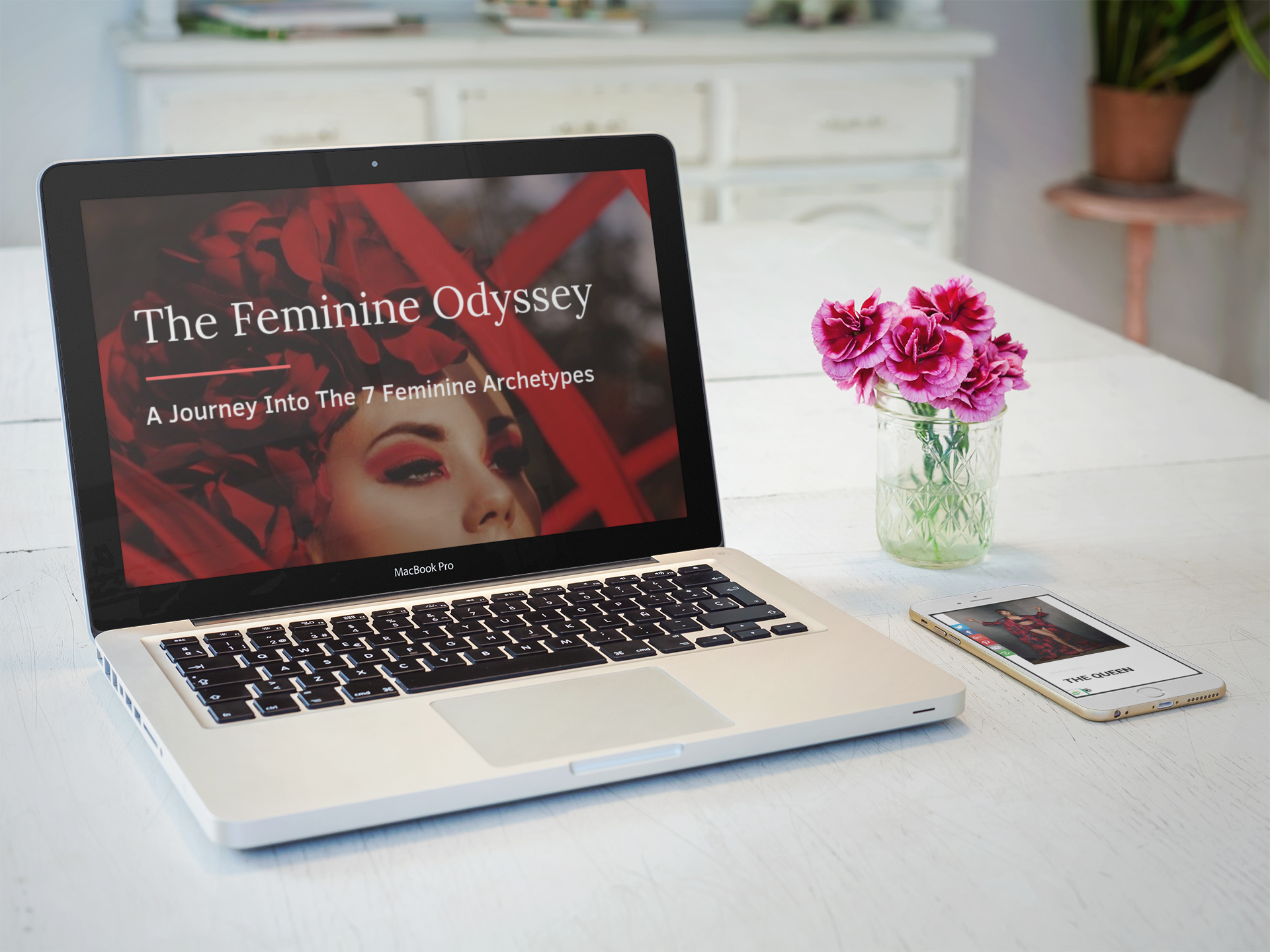
You attract the right things once you have a sense of who you truly are.
To learn how to powerfully activate each archetype, I invite you to explore the Feminine Odyssey is an unprecedented series of seven Master Classes that each dive deep into the 7 feminine archetypes. You can join any individual master class, or discover all seven. With in-depth, documentary-style presentations, daily practices, exercises, affirmations, and prompts, you’ll expand your knowledge of each archetype along with their modern-day and ancient, mythological incarnations. You’ll get access to practical advice about how to use the various archetypes to reach your love, money, and life goals. In about a month, your life can radically change… emotionally, financially, socially, and spiritually.
Allow feminine archetypes to be your inner mirror, and passport to the life you were destined to live.
With passion and power,
Ayesha
PS: Read about your dark side– the shadow aspects of the 7 feminine archetypes here.
©2021. All rights reserved. This article is legally protected by the US copyright office. All attempts to plagiarise or misrepresent the author’s ideas in any form will be prosecuted to the full extent of the law.
Click to learn about the 13 Feminine Seduction Archetypes: Siren | Sophisticate | Boss | Bohemian | Coquette | Goddess | Enigma | Diva | Empress | Sensualist | Lady | Ingenue | Gamine
The founder of Women Love Power®, Ayesha K. Faines is a writer, media personality, and brave new voice for feminine power and social change. Sought after for her provocative insights on culture, mythology and gender politics, she has been featured on MTV, Essence, Entertainment Tonight, The Michael Baisden Radio Show, AfroPunk, and Time among other media outlets. She’s traveled the world lecturing before a number of universities, and she pens a column for Zora Magazine that explores the intersection of love and power. She is best known as a featured panelist on “The Grapevine”. Ayesha is a graduate of Yale University and a former television journalist.
